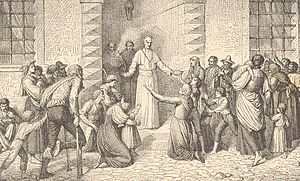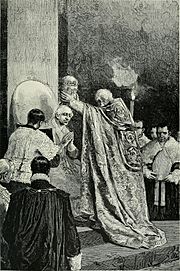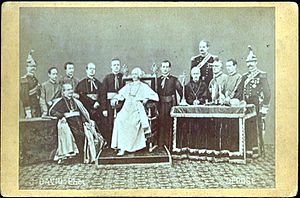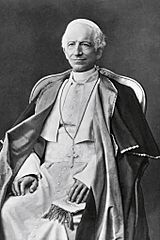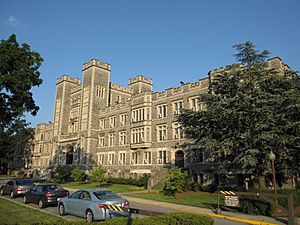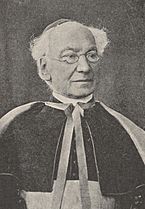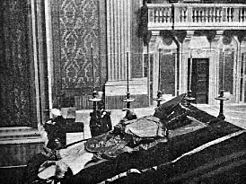Pope Leo XIII facts for kids
Quick facts for kids Pope Leo XIII |
|
|---|---|
| Bishop of Rome | |
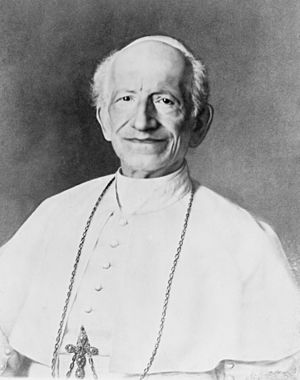
Official photograph, c. 1898
|
|
| Church | Catholic Church |
| Papacy began | 20 February 1878 |
| Papacy ended | 20 July 1903 |
| Predecessor | Pius IX |
| Successor | Pius X |
| Orders | |
| Ordination | 31 December 1837 |
| Consecration | 19 February 1843 by Luigi Lambruschini |
| Created Cardinal | 19 December 1853 |
| Personal details | |
| Birth name | Vincenzo Gioacchino Raffaele Luigi Pecci |
| Born | 2 March 1810 Carpineto Romano, département of Rome, French Empire |
| Died | 20 July 1903 (aged 93) Apostolic Palace, Rome, Kingdom of Italy (now Vatican City) |
| Previous post |
|
| Motto | Lumen in coelo |
| Signature | |
| Coat of arms |  |
| Other Popes named Leo | |
| Papal styles of Pope Leo XIII |
|
|---|---|
 |
|
| Reference style | His Holiness |
| Spoken style | Your Holiness |
| Religious style | Holy Father |
| Posthumous style | None |
Pope Leo XIII (born Vincenzo Gioacchino Raffaele Luigi Pecci; 2 March 1810 – 20 July 1903) was the leader of the Catholic Church from 1878 until his death in 1903. He lived to be 93 years old, making him one of the oldest popes in history. He also had one of the longest reigns, lasting 25 years.
Pope Leo XIII was known for being very smart. He tried to explain the Catholic Church's views on modern ideas. In 1891, he wrote a famous letter called Rerum novarum. In this letter, he talked about the rights of workers. He said they should have fair pay and safe working conditions. He also supported the idea of trade unions. At the same time, he believed in the right to own property and have free businesses. He was against both socialism (where the government controls everything) and laissez-faire capitalism (where businesses have no rules). Because of this letter, people called him the "Social Pope" and the "Pope of the Workers." His ideas helped shape the Church's social teachings for many years.
He also loved the rosary and the scapular, which are special Catholic prayers and items. He was the first pope who did not control the Papal States, which were lands ruled by the Pope. These lands had been taken over by Italy in 1870.
After he died in 1903, he was first buried in St. Peter's Basilica. Later, in 1924, his body was moved to the Archbasilica of Saint John Lateran.
Contents
Early Life and Education
Vincenzo Gioacchino Raffaele Luigi Pecci was born in Carpineto Romano, a town near Rome, on March 2, 1810. He was the sixth of seven sons. His family was very religious. Until 1818, he lived at home with his family.
When he was young, he studied at a Jesuit College in Viterbo with his brother Giuseppe. He loved Latin and wrote his own Latin poems when he was just eleven years old.
In 1824, Vincenzo and Giuseppe moved to Rome because their mother was dying. They stayed with their father and continued their studies at the Jesuit Collegium Romanum.
In 1828, at age 18, Vincenzo decided to become a priest. He studied diplomacy and law at the Pontifical Ecclesiastical Academy. In 1834, he gave a presentation on papal judgments that impressed many important Vatican officials. He helped Cardinal Sala during a cholera outbreak in Rome, working in city hospitals. In 1836, he earned doctorates in theology, civil law, and Canon Law.
Early Career as Administrator
Provincial Administrator in Italy
On February 14, 1837, Pope Gregory XVI made the 27-year-old Pecci a personal prelate. He was ordained a priest on December 31, 1837. Soon after, Pope Gregory XVI appointed Pecci as a provincial administrator in Benevento. This was the smallest papal province.
Pecci faced many problems there, like a struggling economy, bandits, and powerful criminal groups. He bravely arrested a powerful aristocrat and captured many bandits. After bringing back order, he worked to improve the economy and change the tax system to help trade.
Later, in 1841, he was sent to Perugia, a larger province. He prepared the province for a visit from Pope Gregory XVI. In Perugia, he continued to fight corruption. For example, when a bakery was selling bread that was too light, he personally weighed the bread and gave the underweight loaves to the poor.
Diplomat in Belgium
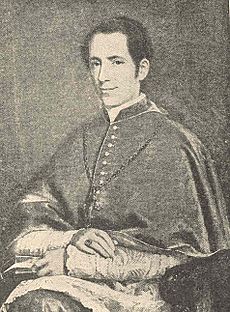
In 1843, at just 33 years old, Pecci was appointed the Pope's representative (Nuncio) to Belgium. This was a very important position.
Pope Gregory XVI made Pecci an Archbishop in April 1843. Pecci became good friends with the Belgian royal family. He also visited Germany to see the Cologne Cathedral.
In 1844, he helped open a Belgian College in Rome. He also spent time in England, learning about the Catholic Church there.
In Belgium, there was a big debate about schools between Catholics and liberals. Pecci supported Catholic schools. He was so well-liked that the King of Belgium gave him a special award.
Archbishop-Bishop of Perugia
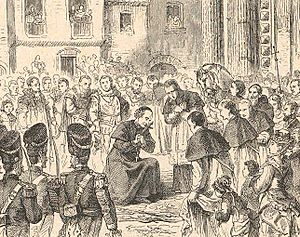
From 1846 to 1877, Pecci served as the popular Archbishop of Perugia. In 1847, after Pope Pius IX allowed more freedom for newspapers, Pecci faced some criticism in the media. In 1848, there were revolutions across Europe. This made things difficult for the Church.
Improving Religious Life
Pecci held a special meeting in 1849 to improve religious life in his area. He invested in making the seminary for future priests larger and hired new, excellent teachers. He even asked his brother, Giuseppe Pecci, a famous scholar, to teach there. Pecci lived next to the seminary, so he could easily talk with the students every day.
Helping Those in Need
Pecci started many Catholic charities to help people. He opened shelters for boys, girls, and elderly women. He also set up a special bank, Monte di Pietà, which gave low-interest loans to people with low incomes. He created soup kitchens, run by Capuchin monks. When he became a cardinal in 1853, he gave all the money meant for celebrations to victims of earthquakes and floods.
Becoming a Cardinal
On December 19, 1853, Pecci was made a Cardinal-Priest. He was given the title of S. Crisogono. Pope Gregory XVI had wanted to make him a cardinal earlier, but he died. Then, events at the start of Pope Pius IX's time delayed it further.
Defending the Church
Pecci strongly defended the Pope and the Church. When Italian authorities took over Catholic buildings, he protested but acted calmly. When the Italian government took over Catholic schools, Pecci added all the regular school subjects to his seminary and allowed non-theology students to attend. The new government also taxed the Church and said that all Church statements needed government approval before being published.
Preparing for the First Vatican Council
In 1869, Pope Pius IX called for a big meeting of Church leaders, known as the First Vatican Council. Pecci was well-informed, and his brother Giuseppe helped prepare for the event.
In his later years in Perugia, Pecci often spoke about the Church's role in modern society. He said the Church was "the mother of material civilization" because it supported the dignity of working people, opposed the bad parts of industrialization, and created many charities for those in need.
In August 1877, Pope Pius IX appointed Pecci as Camerlengo. This meant he had to live in Rome. This job involved managing the Church's property and income, especially when a Pope died.
Papacy: Pope Leo XIII
Becoming Pope
Pope Pius IX died on February 7, 1878. The cardinals met to choose a new Pope. This meeting is called a conclave. They discussed important issues like the relationship between the Church and governments in Europe. Pecci, as the Camerlengo, decided that the conclave should stay in Rome.
On February 18, 1878, the cardinals gathered. Cardinal Pecci was elected Pope on the third vote. He chose the name Leo XIII. He was crowned Pope on March 3, 1878. He chose the name "Leo" because he admired Pope Leo XII, who was interested in education and friendly with other governments.
A Modern Pope
As Pope, Leo XIII worked to help the Church connect with the modern world. He believed that science and religion could exist together. He encouraged the study of Thomas Aquinas, an important theologian. He also opened the Vatican Secret Archives to historians. He even restarted the Vatican Observatory so people could see that the Church supports true science.
Pope Leo XIII was the first Pope whose voice was recorded. You can still hear a recording of him praying the Ave Maria. He was also the first Pope ever filmed by a movie camera. He blessed the camera while being filmed!
Leo XIII brought a sense of calm back to the Catholic Church after a difficult period. His intelligence and diplomatic skills helped the Church regain respect after losing the Papal States. He tried to help the Church connect with working-class people, especially as Europe was changing with new industries. He helped turn around the trend of people leaving the Church for other ideas like socialism.
He was a skilled diplomat and improved relationships with many countries, including Russia, Germany, France, and Britain. He even ordered a hospice to be built inside the Vatican during a cholera outbreak in 1891.
He was known to be a semi-vegetarian. He believed his long life was due to eating little meat and enjoying eggs, milk, and vegetables. His favorite poets were Virgil and Dante.
International Relations
Germany
In Germany, there was a time called the Kulturkampf, which meant "culture struggle." It involved strict rules against the Catholic Church. During Leo's time as Pope, things got better, and the attacks on Catholics lessened.
The Centre Party in Germany represented Catholic interests. Pope Leo's support for social welfare and workers' rights encouraged them. This approach helped Catholic groups in other European countries too.
France
Pope Leo XIII cared deeply for France. He encouraged French Catholics to support the French Republic, even though many were Royalists (supporters of the monarchy). This decision caused some disagreements among French Catholics.
Italy
Leo XIII continued the previous Pope's approach towards Italy. He maintained the Church's position of being "prisoners in the Vatican" and told Italian Catholics not to vote in Italian elections. He had to defend the Church's freedom against what Catholics saw as attacks from the Italian government, especially in education and property. There were even attempts by anti-Church groups to throw the body of the previous Pope, Pius IX, into the Tiber in 1881. Because of this, Pope Leo even thought about moving his home to Austria.
United States
The United States often caught Pope Leo's attention. He approved the decisions of the Third Plenary Council of Baltimore in 1884. He also made James Gibbons, the archbishop of Baltimore, a cardinal in 1886.
On April 10, 1887, Pope Leo XIII officially started The Catholic University of America in Washington, D.C. This became the national university for the Catholic Church in the United States.
Brazil
Pope Leo XIII is also remembered for a meeting of Latin American Church leaders in Rome in 1899. He also wrote a letter in 1888 to the bishops of Brazil, called In plurimis, about ending slavery.
India
Pope Leo XIII encouraged the people of India to become leaders in their own Church. He founded the national seminary, called Papal Seminary, in 1893.
Evangelization
Pope Leo XIII supported missions to Eastern Africa starting in 1884. Catholic missionaries went to countries like Uganda, Tanganyika (now Tanzania), and Rwanda.
In 1887, he approved the creation of the Missionaries of St. Charles Borromeo. These missionaries were sent to North and South America to help Italian immigrants.
Theology and Teachings
Pope Leo XIII's time as Pope was influenced by the First Vatican Council, which had just finished. He wrote many important letters and documents about marriage, family, and the relationship between the Church and society. He also wrote two prayers for Saint Michael the Archangel.
He approved several Scapulars, which are special religious items. These included the Scapular of the Holy Face in 1885 and the Scapular of the Sacred Heart in 1900.
Thomism
As Pope, he strongly supported bringing back Thomism, the ideas of Thomas Aquinas. In 1879, he wrote a letter called Aeterni Patris. This document made Thomism the official way of thinking for the Catholic Church. It was to be taught in seminaries for priests and at universities for everyone.
Pope Leo XIII also created the Pontifical Academy of St. Thomas Aquinas in 1879. He ordered the publication of all of Thomas Aquinas's works in a special edition called the Leonine Edition.
Consecrations

Pope Leo XIII performed several important consecrations. After receiving many letters from Sister Mary of the Divine Heart, he decided to consecrate the entire world to the Sacred Heart of Jesus. In his letter Annum sacrum (1899), he ordered this consecration to happen on June 11, 1899.
Scriptures
In his 1893 letter Providentissimus Deus, he explained how important the Bible is for studying theology. This was a very important document for how the Catholic Church understood and used the Bible.
Relations with Eastern Churches
Pope Leo XIII worked to build good relationships with the Eastern Orthodox Churches. He was against trying to make the Eastern Rite Churches more like the Western (Latin) Church. He said that these Eastern Churches have a very valuable and ancient tradition.
Theological Research
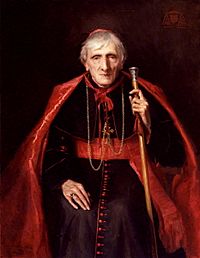
Leo XIII made great efforts in scientific and historical research. He opened the Vatican Archives and supported a large study of the Papacy by historian Ludwig von Pastor.
Mariology
Pope Leo XIII was known as the "Rosary Pope" because he wrote 11 letters promoting the rosary. He also stressed Mary's role in helping humanity and called her Mediatrix (one who helps bring grace).
Social Teachings
Church and State
Leo XIII wanted to help the Catholic Church and the modern world understand each other. However, he was careful about complete freedom of thought. He believed that God created the world and its rules, and that human destiny is more than just earthly things.
Rerum novarum
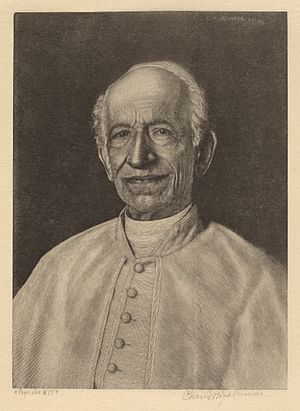
His 1891 letter Rerum novarum was very important. For the first time, a Pope spoke with authority about social inequality and social justice. He focused on the rights and duties of both business owners and workers. He was greatly influenced by Wilhelm Emmanuel von Ketteler, a German bishop who supported working-class people.
Since Leo XIII, popes have continued to expand on the rights and duties of workers and the limits of private property. This includes letters like Pope Pius XI's Quadragesimo anno and Pope John Paul II's Centesimus annus.
Leo argued that both capitalism and communism had problems. Rerum novarum introduced the idea of subsidiarity. This means that decisions should be made at the lowest possible level, rather than by a central authority.
Cardinals Created by Leo XIII
During his time as Pope, Leo XIII appointed 147 new cardinals. He never went over the limit of 70 cardinals set by an earlier Pope. He appointed cardinals from outside Europe, including the first cardinals from Australia, Canada, Slovenia, and Armenia.
He made John Henry Newman a cardinal, which was praised in English-speaking countries. He also made his own brother, Giuseppe Pecci, a cardinal. In 1893, he made Giuseppe Melchiorre Sarto a cardinal, who would later become the next Pope.
Saints and Blesseds
Pope Leo XIII officially recognized several people as saints (canonized them) and blesseds (beatified them) during his time.
He canonized:
- Clare of Montefalco, John Baptist de Rossi, Lawrence of Brindisi, and Benedict Joseph Labre (1881)
- The Seven Holy Founders of the Servite Order, Peter Claver, John Berchmans, and Alphonsus Rodriguez (1888)
- Antonio Maria Zaccaria and Peter Fourier (1897)
- John Baptist de la Salle and Rita of Cascia (1900)
He also beatified several of his predecessors, including Urban II and Victor III.
Doctors of the Church
Leo XIII named four individuals as Doctors of the Church, which is a special title given to saints whose writings and teachings are especially important for the Church. These were:
- Cyril of Alexandria and Cyril of Jerusalem (1882)
- John of Damascus (1890)
- Bede the Venerable (1899)
Audiences with the Pope
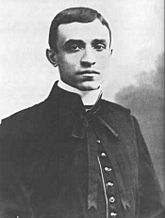
One of the first people Leo XIII met with was a young student named Giacomo Della Chiesa, who would later become Pope Benedict XV.
In 1887, Thérèse of Lisieux, a young girl who later became a saint, met Pope Leo XIII. She asked him if she could join the Carmelite order even though she was only 15. The Pope told her, "You will enter if God wills it." She joined the Carmelites shortly after.
There is a story about how Leo XIII wrote the Prayer to Saint Michael. It is said that in 1884, after Mass, he had a vision of demons being released from Hell. He then saw Saint Michael driving them back. After this, he wrote the prayer and asked that it be said after every Mass. However, historians have not found clear proof of this vision in his own writings.
Health and Final Years
When he became Pope in 1878, Leo XIII had a slight tremor in his hand. In March 1899, people thought he was very sick and close to death. It turned out he had an inflamed cyst that had been bothering him for almost 30 years. He had surgery, and the cyst was removed.
Towards the end of his life, he sometimes used a gold-headed cane to help him walk. He was known to walk quickly to show people he was healthy when rumors spread about his declining health.
Death
On June 30, 1903, Pope Leo XIII felt unwell. He caught a cold on July 3, and his condition quickly worsened to pneumonia. On July 4, he made his last confession. He said, "I am now near my end. I do not know if all I have done has been good, but I certainly obeyed my conscience and our faith."
He received sacraments and continued to weaken. On July 7, he asked for his window shutters to be opened, saying, "I wish to see once more, perhaps for the last time, the rays of the sun."
Pope Leo XIII died at 3:55 pm on July 20, 1903, after giving a final blessing. He was 93 years old. He was the first Pope born in the 19th century and the first to die in the 20th century. At the time of his death, he was the second-longest-reigning Pope.
He was first buried in St. Peter's Basilica. Later, in late 1924, his remains were moved to the Archbasilica of Saint John Lateran, which was his cathedral church as the Bishop of Rome.
See also
 In Spanish: León XIII para niños
In Spanish: León XIII para niños
- Cardinals created by Leo XIII
- Distributism
- Prayer to Saint Michael
- Restoration of the Scottish hierarchy
- List of popes
- Papal Navy



